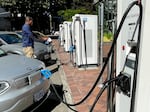New cars sold in Oregon and Washington will have to be emissions-free starting in 2035. The rules adopted Monday by both states will mean an end to the sale of new gas- and diesel-powered trucks, passenger cars and SUVs up and down the West Coast.
The states are on track to align their own zero-emission vehicle rules with the policy in California, whose Air Resources Board voted in August to set a zero-emissions standard for new vehicles sold there beginning in 2035.

In this OPB file photo from Sept. 8, 2022, JR Anderson views charging stations in Portland's Electric Avenue. Oregon and Washington will ban the sale of new gas-powered vehicles starting in 2035.
Monica Samayoa / OPB
Banning the sale of new vehicles powered by gasoline or diesel means all new vehicles sold on the West Coast will have to be powered by electric batteries. plug-in hybrid electric motors or fuel cell systems.
Oregon Environmental Quality Commission members who voted for the Advanced Clean Car II emission standards said those standards are imperative to meeting the state’s goals for reducing carbon pollution that contributes to climate change.
According to an Oregon Department of Environmental Quality report, Oregon’s transportation sector accounts for 40% of total greenhouse gas emissions – the largest single source in the state.
Public hearings in the fall drew criticism from opponents, who said consumers are being forced to make more expensive vehicle purchases.
Related: As Oregon pushes more electric vehicles, a gap emerges in access
The Department of Environmental Quality’s data shows that, with the exception of pickup trucks, the cost of electric vehicles will reach parity with internal combustion engine vehicles between 2030 and 2033. After that, EVs are projected to cost less than internal-combustion engine vehicles. Pickups would not reach that parity point until after 2035.
The gas-vehicle bans come as regional and national policymakers are trying to transition motorists toward carbon-emissions-free vehicles. Oregon offers two electric vehicle rebates, which combined can total up to $7,500 for a new electric vehicle.
Related: Following California’s lead, Oregon exploring ban on gas-powered vehicles
This year’s Inflation Reduction Act passed by Congress and signed by President Joe Biden appropriates $369 billion for clean energy and climate action. That includes federal tax breaks of up to $7,500 for a qualifying new electric vehicle and up to $4,000 for a used one for households with low-to-moderate income. Between the state and federal tax incentives, certain Oregonians can get up to $15,000 in rebates for a new electric vehicle.
Departing Oregon Gov. Kate Brown has set a goal to have at least 250,000 registered electric vehicles in the state by 2025. There are now more than 50,000.
Oregon also has plans to spend $100 million on fast-charging stations for electric vehicles along major roadways, with a focus on serving disadvantaged communities and rural communities, over the next five years.
Leah Feldon, the Oregon Department of Environmental Quality’s interim director, said the zero-emissions vehicle rule for 2035, combined with Oregon’s other policy steps, will help Oregon address climate change, as well as the health risks for communities near major roadways where tailpipe emissions are concentrated.
“The commission’s action puts the state in a position to expand our charging infrastructure and ensure grid reliability,” she said in a statement. “It also incentivizes auto manufacturers to send all electric model options to Oregon.”
Washington’s Legislature set the stage for Monday’s zero-emissions vehicle rules when it passed the Motor Vehicle Emissions Law in 2020. That required Washington to follow California’s motor vehicle emission standards.











